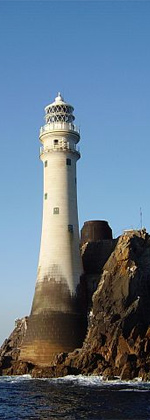Design and construction
Though Irish engineer Alexander Mitchell went blind in 1802 (before he turned 23), [1] he patented the screw-pile mooring in 1833, [2] and built the first screw-pile lighthouses in 1838. [3] These lighthouses included the Maplin Sands Light (1838) and Wyre Light (1839) in England. [4]
Based from Belfast, Mitchell moved to Cobh (then called Queenstown) in 1851 to supervise the foundation works for a lighthouse on the Spit Bank. [5] [6] Located in a relative shallow between Spike Island and Cove Fort, the lighthouse replaced an unlit buoy which marked a turn required by shipping to follow Cork Harbour's main navigable channel. [7] Despite his blindness, with assistance from his son and grandson, Mitchell reportedly supervised some of the work directly. [5] Contemporary accounts record how he was personally involved in construction of a number of his structures, transiting to the work sites in small boats, crawling on planks and examining joints by touch. [4] While living in the area, he also befriended logician George Boole – who was based at Cork's university. [4]
The structure's platform is supported by nine cast-iron screwpiles 60 centimetres (2.0 ft) in diameter and driven approximately 5.2 metres (17 ft) into the sea-bed. [8] The main light and octagonal sheet-iron lighthouse was designed by the engineer to the Commissioners of Irish Lights, George Halpin. [9] [10] With the foundation work laid relatively quickly, [11] the lighthouse was first lit in 1853. [9]
Operation
Spit Bank under repair in 2013
Located less than a half-mile from shore, and with no permanent accommodation, the light was managed by keepers who transited from the nearby town of Cobh. [4] A foghorn was added in the late 19th century, and the light updated and automated in the 20th century. [7] In use for more than 150 years, and one of only three remaining screw-pile lighthouses in Ireland, it was repaired following a collision in 1978, [1] and renovated in 2013. [12] [13]
As of 2016 it remained a working light, with a focal plane of 10 metres (33 ft) and white and red light lenses – depending on direction of approach. [12] The Port of Cork uses the Spit Bank Lighthouse as a boundary marker for the compulsory pilotage of large vessels entering the middle harbour. [14] [15] [16]
This page is based on this
Wikipedia article Text is available under the
CC BY-SA 4.0 license; additional terms may apply.
Images, videos and audio are available under their respective licenses.





